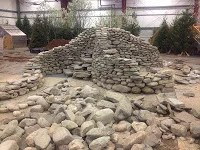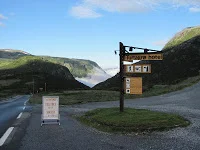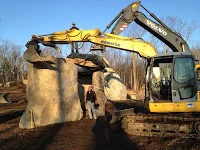The desire to commemorate a life in passing is a deeply held impulse. To create something new is a natural response to the experience of loss. The “Stone Arch Arbor” commission combines a family’s wish to remember a loved one and make a gift to his community.
Read MoreWorking with “free stone” offers freedom from and freedom to. The basic rules of dry stone walling, as outlined by the DSWA, are simple and effective. When they’re applied, at home, for a client, in a workshop or during certification testing, no second-guessing is required. The path forward is clear if not always straight. To a large degree, the rules create freedom from uncertainty.
Read MoreThe stone globe I built in 1983 had become timeworn. The hollow construction cracked open under the strain of carrying its own heft for thirty years. Barbara and Ernie commissioned the original. Their daughter, Nicole, asked me to bring it back to its former glory. In the intervening years I’ve laid up hundreds of dry stone constructions. I like to think I’ve learned a new thing or two along the way. The process of rebuilding the ball taught me that I both have, and haven’t.
Read MoreWhile I was in Newfoundland, ET, John, Andy, and the rest of the crew were making a full size mockup of the three-stone piece that will soon be installed on Hogpen Hill. The “inflatable stones,” as ET refers to them, are made from steel frames sheathed in plastic shrink-wrap. Yesterday the mockup took flight, with the aid of the excavator bucket, around the field seeking a site for the permanent installation.
Read MoreDue to a number of structural problems, an eight-year-old, dry stone retaining wall in Hanover, New Hampshire was dangerously close to collapsing. I was asked by the property owner to remedy the situation. The rebuilding of a 6’x30’ section of retaining wall is often a straightforward business. But because this wall was in a well established, backyard garden with poor access and little room to store materials at the site, the build was a logistical puzzle. Concern was added to those challenges when, as work commenced, a municipal sewer line was discovered to be located scarily close to the back of the wall.
Read MoreTwo days worth of indoor stone slinging last week completed the central stone feature at the Vermont Flower Show. Jared, T.J., Jamie, Brian and I finished up “Craggy Mountain” just as the trees, mulch and flowers closed in around us. On Friday I offered my slide-talk, “Working Stone,” to a standing-room-only crowd. The following words were part of the presentation’s introduction.
Read MoreThe past two days have been a swirl of activity as months of planning finally came together, including the 25-ton dry stone installation created by Jared Flynn, Jamie Masefield, T.J. Mora, Brian Post and me. Behind the scenes, Charley McMartin coordinated the collection and delivery of the stone and will take care of the break-down Sunday night.
Read MoreThe age-old skill of constructing in dry stone is still alive today and being practiced by a growing number of professional wallers. Two weeks from now, a team of DSWA certified craftsmen from around the region will meet at the Champlain Valley Fairgrounds in Essex Junction, to create a unique feature (scale model in photo) for the upcoming Vermont Flower Show.
Read MoreEvery baker knows it takes good ingredients to make a tasty pie. Now that plans for the dry stone workshop at Turtagrø, Norway have come together, I can see that our week in July is going to be a fantastic time. We have a beautiful setting, excellent accommodations and an abundance of building stone. All that’s missing are a few more enthusiastic folks to sign up and meet us at Tutagrø. I hope you will be the one who completes the pie!
Read MoreGetting to work with skilled professionals under the direction of an artist who takes great joy in the making of things is pure delight for me. This week I was again on Hogpen Hill with Edward Tufte creating monumental lithic assemblages. From time to time, over the past year, I’ve gone to western Connecticut to collaborate with my stone-loving colleague. With each session, we’ve explored new ways to combine large stones with the landscape. The stones are dug up from just under the surface of the ground near the assembly points. Each “foundling” is a gift of unique shape and texture bringing with it another possibility for construction.
Read MoreThe best two days in the life of a dry stone project are the first and the last. The first day is full of anticipation about how the great unknown will reveal itself. The course of the work has been formulated in the mind, but the process that will lead to an end only begins when an actual stone is laid. That initial stone sets in motion a chain-reaction of events, a series of choices that ultimately determine the character of the finished work.
Read MorePaul Bowen brought his Marlboro College sculpture class students to my work site today for a flash course in dry stone walling, and an outdoor "gallery" tour of nearby installations. My normally quiet scene became very lively for an hour as the group practiced building a field-stone retaining wall.
Read MoreMy project this month is the construction of a series of retaining walls for an existing perennial garden. A brook trickles from the bank at the top of the garden and flows through a channel between two of the new walls. The grotto will become an ice cavern in winter months and a cool, shady retreat in the heat of summer.
Read More“Walls of Snowdonia”; it could be the title of a fantasy video game featuring my stoneworks. But, no, Snowdonia is a real place, and although I did make some stone wall repairs in Wales while visiting Philip Clark in the early 1990’s those walls are not included in this folio of beautiful photographs by Peter Ogwen Jones, Walls of Snowdonia. In fact, these beautiful examples of the waller’s craft were constructed more than a century ago. They continue to stand as testaments to the enduring value, practical and aesthetic, of handmade structures in the living landscape.
Read MoreEdward Tufte and the crew at Hogpen Hill Farms stayed busy on the land while I was away in Newfoundland and Oregon. An exciting collection of stones greeted me on arrival this past Monday. Edward’s sketches illustrated the direction he wished to move the work. Frank, Rob, Tom and I got right into it, constructing an 14’ high A-frame shaped piece. By Wednesday we were back on the ridgeline connecting the network of dolmens built earlier in the summer with high cross-members. A three-stone colossus now frames a dramatic view of the extended works.
Read MoreWhen I’ve thought of the people who lived on the land that’s now America, one, two, ten thousand years ago, I’ve imagined that they led a simple, subsistence lifestyle. But after visiting an ancient agate adit in central Oregon I now have to adjust my vision of the past to include a more sophisticated cultural landscape.
Read MoreThe 34-stone construction is made from stream-worn “pillow” basalt boulders gathered from a gravel bank along the Santiam River in Mill City, Oregon and 70 year-old hand split, cast-offs collected from an abandoned granite quarry in Haines, Oregon. The stones are held in place by gravity and friction aided by stainless steel pins for lateral strength. The total weight of the piece is 15 tons, the largest stone weighing 4 tons. The piece covers a 10’x30’ area and is 6’ tall at it’s highest point.
Read MoreThe 34-stone construction is made from stream-worn “pillow” basalt boulders gathered from a gravel bank along the Santiam River in Mill City, Oregon and 70 year-old hand split, cast-offs collected from an abandoned granite quarry in Haines, Oregon. The stones are held in place by gravity and friction aided by stainless steel pins for lateral strength. The total weight of the piece is 15 tons, the largest stone weighing 4 tons. The piece covers a 10’x30’ area and is 6’ tall at it’s highest point.
Read More
















